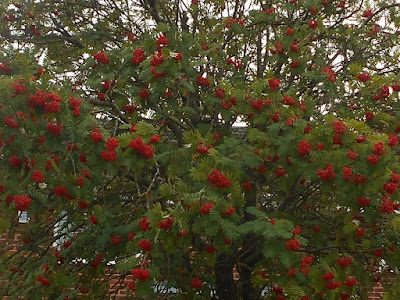The first was encountered before reaching the reserve.
 |
Bedeguar galls on dog rose near Byfield Pool.
27 August, 2018
|
Bedeguar galls, caused by the wasp Diplolepis rosae, are often noticed in mid-winter, looking brown and tatty, but at this time of the year they are of an attractive cherry red. Over the next few weeks other insects, known as inquilines, will also take up residence in the gall, without apparently causing harm. The eventual result will be a complex community.
Once in the reserve other galls were noted. An oak sapling bore two very obvious marble galls, the work of another wasp, Andricus kollari, but a closer look revealed yet another.
 |
A couple of Ramshorn Galls can be seen a little below the Marble Galls.
Byfield Pool, 27 August, 20118
|
The Ramshorn Gall is very distinctive, bearing a pair of tapering projections. The actual form is quite variable but two examples can be seen a little below the Marble Galls. This wasp bears the appropriate name of Andricus aries and anyone born under the zodiacal sign of the ram will note the link. The gall is common but easily overlooked.
A fallen log sported an interesting fungus but, being a mere tyro in the field of mycology I hesitate to name it. It may be Oxyporus latemarginatus but it will not appear on my list of recorded species.
 |
Oxyporus latemarginatus? Perhaps, but I cannot be sure.
Byfield Pool. 27 August, 2018
|
One disappointment: I had hoped to find a range of bugs (true bugs, that is) but my haul was a paltry one and diptera - two-winged flies - formed the bulk of my 'bag'. However I expect that, once identified, these and other organisms will do much to raise the profile of this reserve.
The pool and its surroundings are the property of the Canal and River Trust and the status of the site as a nature reserve is contentious. It may eventually be dropped from the reserves managed by the Northants Wildlife Trust and in my opinion this would be a great pity. Much of the waterside vegetation I would define as 'carr' and over the decades drainage has made this a relatively uncommon habitat in Northants. A proper investigation would probably show a range of scarce species still occupy this reserve and to lose it would be unfortunate. If anything the reserve should be extended eastwards to include Parson's Spinney, but that is a pipe dream.













































